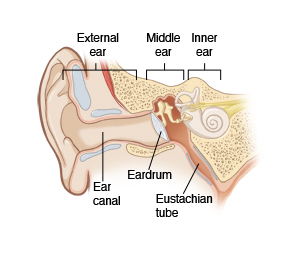Ruptured Eardrum, Traumatic

The eardrum (also called the tympanic membrane) is a thin membrane that separates the middle ear and the external ear. It's easily injured by foreign objects put into the ear canal. It may also be harmed by very loud noises close to the ear, such as a gunshot or a powerful slap to the ear. And it can be injured by trauma to the head or ear.
A burst (ruptured) eardrum can occur from pressure changes caused by a blast or explosion, flying, scuba diving, or driving in the mountains. Inserting cotton swabs or small objects can also rupture the eardrum. A ruptured eardrum can cause pain. There may be clear or bloody drainage. A buzzing sound may be heard in the ear. In severe cases, you may get dizzy or feel like you are spinning. Some hearing may be lost in the affected ear.
The goal is to keep the ear dry and clean until the eardrum heals. Antibiotics may be prescribed if infection is present. Follow-up with ear and hearing specialists is advised. In many cases, hearing returns to normal after the eardrum heals. But surgery may be needed in severe cases.
Home care
-
Keep your ear dry. You can put a cotton ball lightly coated with petroleum jelly in the outer part of the ear. You can also ask your doctor for other advice on how to prevent your eardrum from getting wet when taking a shower.
-
Don't use cotton swabs in your ear.
-
Don't use eardrops unless prescribed by your doctor.
-
Don't get water in your ear when showering or bathing. No swimming until approved by your doctor.
-
Don't do air travel or diving until approved by your doctor.
-
Take any prescription or over-the-counter medicines as advised.
Follow-up care
Follow up with specialists for test or exams as directed. A hearing test should be done soon after the injury. Also follow up within 2 weeks, or as directed by your doctor, to check healing of the eardrum.
When to contact your doctor
Contact your doctor if:
-
Your child has a fever (see "Fever and children" below).
-
You have a fever of 100.4°F (38°C) or higher, or as advised by your doctor.
-
Fluid is leaking from the ear for longer than 24 hours.
-
You have more ear pain.
-
You have headache or dizziness that gets worse.
-
You have hearing loss that gets worse.
Fever and children
Use a digital thermometer to check your child’s temperature. Don’t use a mercury thermometer. There are different kinds and uses of digital thermometers. They include:
-
Rectal. For children younger than 3 years, a rectal temperature is the most accurate.
-
Forehead (temporal). This works for children age 3 months and older. If a child under 3 months old has signs of illness, this can be used for a first pass. The doctor may want to confirm with a rectal temperature.
-
Ear (tympanic). Ear temperatures are accurate after 6 months of age, but not before.
-
Armpit (axillary). This is the least reliable but may be used for a first pass to check a child of any age with signs of illness. The doctor may want to confirm with a rectal temperature.
-
Mouth (oral). Don’t use a thermometer in your child’s mouth until they are at least 4 years old.
Use a rectal thermometer with care. Follow the product maker’s directions for correct use. Insert it gently. Label it and make sure it’s not used in the mouth. It may pass on germs from the stool. If you don’t feel OK using a rectal thermometer, ask the doctor what type to use instead. When you talk with any doctor about your child’s fever, tell them which type you used.
Below is when to call the doctor if your child has a fever. Your child’s doctor may give you different numbers. Follow their instructions.
When to call a doctor about your child’s fever
For a baby under 3 months old:
-
First, ask your child’s doctor how you should take the temperature.
-
Rectal or forehead: 100.4°F (38°C) or higher
-
Armpit: 99°F (37.2°C) or higher
-
A fever of ___________as advised by the doctor
For a child age 3 months to 36 months (3 years):
-
Rectal or forehead: 102°F (38.9°C) or higher
-
Ear (only for use over age 6 months): 102°F (38.9°C) or higher
-
A fever of ___________ as advised by the doctor
In these cases:
-
Armpit temperature of 103°F (39.4°C) or higher in a child of any age
-
Temperature of 104°F (40°C) or higher in a child of any age
-
A fever of ___________ as advised by the doctor